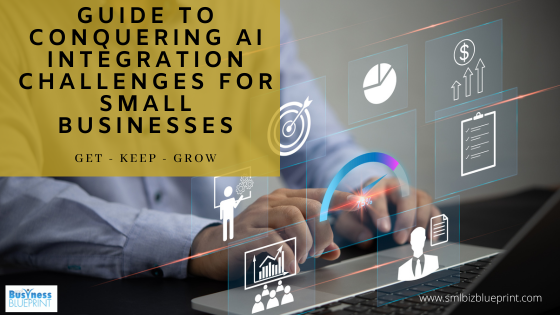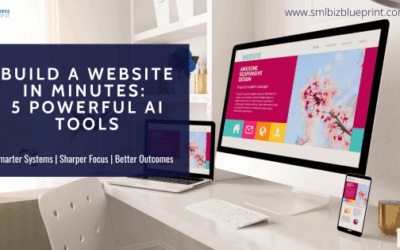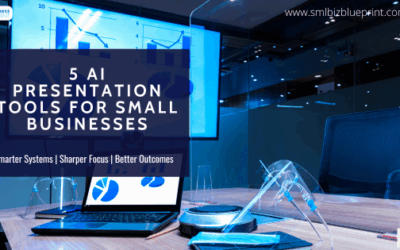Today, small businesses are poised for transformation, propelled by the advent of artificial intelligence (AI).
We will delve into the dynamic world of AI implementation, a journey fraught with promise yet peppered with challenges.
From deciphering the initial investment in “AI startup costs” to fortifying “AI data protection,” this comprehensive guide is tailored for the ambitious yet pragmatic small business owner.
Embarking on the AI journey heralds many questions:
- How does one balance the scales of investment and return?
- What measures ensure the sanctity of customer data?
- How can a business without a deep well of AI knowledge harness this technology effectively?
Addressing these inquiries head-on, our blog post demystifies the “affordable AI solutions for SMBs” and navigates the intricate tapestry of “ethical AI practices,” ensuring your venture into AI is profitable and principled.
Join us as we explore the multifaceted realm of AI in small business, from leveraging “scalable AI solutions” that grow with your enterprise to enhancing “customer relationships” through intelligent automation.
Whether you’re contemplating “AI implementation costs” or seeking to “compete with industry giants,” our insights will illuminate the path forward. This is not just about surviving in the age of digital transformation but thriving by making informed, strategic decisions in your AI journey.

#1 Evaluating AI Implementation Costs for SMBs
The journey into artificial intelligence (AI) for small and medium-sized businesses (SMBs) begins with a crucial step: understanding and managing the initial costs.
The allure of AI’s potential benefits—streamlined operations, enhanced customer experiences, and insightful data analytics—is often tempered by the apprehension of hefty investment requirements.
However, the “AI startup costs” landscape is not as daunting as it appears, especially when navigated with strategic acumen.
Breaking Down the Costs:
At the heart of AI implementation are three core financial considerations: software, hardware, and talent.
Software expenses vary widely depending on whether you opt for custom-developed solutions or ready-made platforms.
Hardware costs, though less of a concern with the rise of cloud computing, can still be significant for data-intensive applications.
Talent acquisition poses the most significant challenge, as hiring AI experts can be costly.
Cost-Effective Strategies:
The good news for SMBs is that the AI market has matured, offering many cost-effective, scalable solutions. Starting small with modular, cloud-based AI services can dramatically reduce upfront costs.
These platforms offer pay-as-you-go models that scale with your business, ensuring you only pay for what you need. Additionally, leveraging open-source AI tools can minimise software expenses, although it may require more technical prowess.
Phased Implementation:
A phased approach to AI adoption can further mitigate financial risk. Begin with pilot projects that address specific, high-impact areas of your business.
This keeps initial costs low and allows you to measure ROI more effectively, guiding further investments based on tangible outcomes.
The Role of Funding and Grants:
It’s also worth exploring external funding opportunities. Many governments and private institutions offer grants and subsidies for small businesses looking to innovate through technology.
These can provide a much-needed financial cushion for your AI initiatives.
The Bottom Line:
The key to managing “AI implementation costs” lies in strategic planning and leveraging the right resources. By starting small, focusing on scalable solutions, and taking advantage of external funding, SMBs can navigate the financial challenges of AI adoption and turn AI’s promise into a tangible competitive advantage.
#2 Fortifying Data Privacy and Security in AI
Data is the lifeblood of artificial intelligence (AI) in the digital age, fueling algorithms that can transform small business operations. Yet, with great power comes great responsibility—especially when safeguarding the privacy and security of the data at the heart of AI systems.
For small and medium-sized businesses (SMBs), navigating the complexities of “AI data protection” is not just about compliance; it’s about building trust with your customers and securing your business’s future.
Understanding Data Regulations:
The first step in fortifying data privacy is understanding the legal landscape, including regulations like GDPR in Europe and various state-level laws in the U.S. These regulations set the baseline for data handling practices, emphasising the need for consent, transparency, and the right to data deletion.
Familiarising yourself with these requirements is essential to ensure your AI implementations are compliant and ethical.
Implementing Robust Security Measures:
Protecting your AI systems from breaches requires a multi-layered security strategy. This begins with encrypting data at rest and in transit—to protect sensitive information from unauthorised access.
Access control mechanisms ensure that only authorised personnel can interact with your AI systems, minimising the risk of internal breaches.
Regular security audits and penetration testing can identify vulnerabilities in your systems before malicious actors can exploit them. Investing in cybersecurity training for your staff can significantly reduce the risk of human error, one of the most common security vulnerabilities.
Anonymization and Data Minimization:
Whenever possible, use data anonymisation techniques to protect user privacy. This involves stripping away personally identifiable information from datasets, ensuring that the data cannot be traced back to individual users.
The principle of data minimization—collecting only the data that is absolutely necessary for your AI applications—can further reduce privacy risks.
Transparent AI Practices:
Transparency in collecting, using, and protecting data helps in regulatory compliance and builds customer trust. Communicate your data handling practices to your customers, including how AI uses their data and what measures are in place to protect it.
Securing AI Against Attacks:
AI systems can be targets for sophisticated attacks designed to manipulate their behaviour. Techniques like adversarial training, where the AI is exposed to malicious inputs during its training phase, can help build resilience against such attacks.
The Takeaway:
Ensuring “secure AI platforms” for small businesses means going beyond mere compliance; it involves adopting a proactive stance towards data privacy and security.
By understanding the regulatory landscape, implementing robust security measures, and embracing transparency, SMBs can harness the power of AI without compromising the trust and safety of their customers’ data.
#3 Maximising AI’s Return on Investment
For small and medium-sized businesses (SMBs) venturing into artificial intelligence (AI), the ultimate litmus test of success is the return on investment (ROI).
Navigating the “AI ROI for small businesses” landscape requires a strategic approach, focusing on the immediate benefits and the long-term value AI can bring. This section delves into how SMBs can maximise their AI investments, transforming potential into profitability.
Identifying High-Impact Areas:
The first step in securing a strong ROI is identifying areas where AI can significantly impact your business. This could range from automating repetitive tasks to enhancing customer service or gaining insights from data analytics.
Prioritising projects that align closely with your business goals and customer needs ensures that your AI investments are focused and impactful.
Setting Realistic Expectations:
Setting realistic expectations for what AI can achieve in your specific context is important. While AI offers remarkable capabilities, it’s not a silver bullet for all business challenges.
Understanding the limitations and setting achievable goals for your AI projects can help align investments with potential outcomes.
Measuring Success Beyond Financial Gains:
While financial returns are paramount, AI’s benefits often extend beyond immediate revenue increases. Improved customer satisfaction, higher employee productivity, and enhanced decision-making capabilities are just some intangible benefits contributing to the overall ROI.
Developing a comprehensive metrics system that accounts for financial and non-financial returns can provide a more nuanced view of AI’s value to your business.
Leveraging AI for Competitive Advantage:
In a crowded market, AI can provide SMBs with a competitive edge. Whether through personalised customer experiences, streamlined operations, or innovative products and services, AI can differentiate your business from competitors.
Though difficult to quantify, this competitive advantage is critical to the ROI, driving long-term growth and market positioning.
Continuous Learning and Adaptation:
AI is not a set-it-and-forget-it solution. Maximising ROI requires continuous monitoring, learning, and adaptation.
As your AI systems gather more data and insights, revisiting and refining your strategies will ensure that your AI implementations remain aligned with evolving business objectives and market conditions.
The Bottom Line:
Achieving a high ROI on AI investments demands a strategic approach, from selecting high-impact projects to continuously adapting AI strategies to business growth.
For SMBs willing to navigate these complexities, the rewards of AI can significantly outweigh the initial investments, setting the stage for sustained success and innovation.

#4 Building AI Expertise Within Your Team
The successful implementation of artificial intelligence (AI) in small and medium-sized businesses (SMBs) hinges on the technology and the people behind it. Building AI expertise within your team is pivotal to leveraging AI’s full potential while ensuring sustainable growth.
This section explores actionable strategies for nurturing AI talent within your organisation, aligning skills with strategic business goals.
Assessing Your Current Talent Pool:
Begin by evaluating your team’s existing level of AI knowledge and skills. Understanding the gaps is crucial for planning targeted training programs or identifying new hires’ needs.
This initial assessment can be facilitated through surveys, skill assessments, or consultations with AI experts.
Tailored Training Programs:
Once you’ve identified the skill gaps, the next step is to design or invest in training programs that meet your specific needs. These programs can range from online courses and workshops to attending AI conferences and webinars.
Prioritise training that offers practical, hands-on experience, ensuring that your team can apply their new knowledge directly to your business’s AI projects.
Leveraging External Resources:
Small businesses often operate with limited resources, making it challenging to develop in-house training programs. In such cases, leveraging external resources becomes vital.
Collaborate with local universities, online education platforms, and professional organisations that offer specialised AI courses.
Many of these institutions provide courses tailored to business professionals, focusing on applying AI in business contexts rather than just theoretical knowledge.
Encouraging a Culture of Continuous Learning:
Building AI expertise is not a one-time effort but a continuous process. Foster a culture that values ongoing education and curiosity.
Encourage your team to stay updated with AI trends, tools, and best practices. This can be supported by setting aside dedicated time for learning, providing access to learning resources, and even incentivising acquiring new skills.
Hiring AI Talent:
Sometimes, hiring new talent is the fastest way to bring AI expertise into your business. When recruiting, look for individuals who possess the necessary technical skills and align with your company’s culture and values.
Given the competitive market for AI professionals, consider roles that offer growth opportunities, creative freedom, and the chance to work on impactful projects to attract top talent.
Collaborations and Partnerships:
For many SMBs, building a full-fledged AI team from scratch may not be feasible. An alternative approach is to collaborate with universities, research institutions, or AI consultancies.
These partnerships can provide access to cutting-edge knowledge, resources, and even temporary talent through interns or project-based consultants.
The Takeaway:
Developing AI expertise within your team is a multifaceted endeavour beyond mere technical training. It involves assessing current capabilities, providing tailored learning opportunities, fostering a culture of continuous improvement, and strategically augmenting your team with new hires or partnerships.
By empowering your team with AI knowledge and skills, your business is better positioned to harness AI’s transformative potential, driving innovation and competitive advantage.
#5 Adhering to Ethical AI Practices
In the whirlwind of excitement that artificial intelligence (AI) brings to small and medium-sized businesses (SMBs), it’s crucial not to overlook the ethical dimensions of this powerful technology.
Ethical AI practices are not just moral imperatives; they are foundational to building trust with your customers and ensuring the longevity of your AI initiatives.
This section delves into the principles of ethical AI use and how SMBs can integrate these practices into their AI strategies.
Understanding Ethical AI:
At its core, ethical AI is about ensuring that AI technologies are developed and used fairly, transparently, and accountable. This includes considerations like avoiding bias in AI algorithms, respecting user privacy, and ensuring AI decisions are explainable and justifiable.
Mitigating Bias in AI Systems:
Bias in AI can lead to unfair outcomes, such as discriminatory practices or unequal service levels. Diverse datasets and perspectives must be involved in AI development to combat this.
Regularly audit your AI systems for bias and take corrective actions when necessary. Tools and methodologies for AI fairness assessment can be invaluable in this regard.
Transparency and Explainability:
Your stakeholders, including customers and employees, should understand how and why AI makes certain decisions. Strive for transparency by documenting your AI systems’ data, algorithms, and processes.
Use explainable AI models that allow insight into decisions, fostering trust and accountability where possible.
Data Privacy and Consent:
Ethical AI is inextricably linked to data privacy. Ensure that your AI systems comply with data protection laws and go beyond mere compliance to respect the spirit of these regulations.
This means being clear about how you collect, use, and store data and obtaining informed consent from individuals whose data is being used.
Engaging with Stakeholders:
Ethical AI practices should involve dialogue with all stakeholders, including customers, employees, and the broader community. Engage with these groups to understand their concerns and expectations regarding AI.
This not only helps in identifying potential ethical issues but also builds a culture of trust and inclusivity.
Developing an AI Ethics Policy:
Consider developing a clear AI ethics policy to formalise your commitment to ethical AI. This document should outline fairness, transparency, accountability, and privacy principles.
It serves as a guide for your team and a statement of your values to the outside world.
Leveraging Ethical AI Frameworks:
Numerous organisations and industry bodies have developed ethical AI frameworks and guidelines. These resources can provide valuable guidance on best practices and help you benchmark your efforts against industry standards.
The Takeaway:
Embracing ethical AI practices is not just about mitigating risks; it’s about enhancing AI’s value to your business and society. By prioritising fairness, transparency, and privacy, SMBs can harness AI’s potential in a manner that respects individual rights and fosters long-term trust.
As AI becomes more integral to business operations, those who lead with ethics will set a standard for responsible innovation and secure a competitive edge in the trust-driven economy of the future.
#6 Choosing Scalable AI Solutions for Growth
Scalability is critical for small and medium-sized businesses (SMBs) embarking on the artificial intelligence (AI) journey. The ability to grow and adapt your AI solutions as your business evolves ensures that your investment continues to deliver value over the long term.
This section explores how SMBs can select and implement AI solutions that are effective today and scale with their future growth.
Identifying Scalable AI Platforms:
Begin by choosing AI platforms and tools designed for scalability. Cloud-based AI services, for example, offer the flexibility to increase or decrease resources according to demand, making them ideal for businesses in growth mode.
When evaluating potential AI solutions, consider their integration capabilities, customisation options, and the provider’s track record for updates and support.
Starting Small with a Growth Mindset:
Implementing AI doesn’t have to mean a massive upfront investment. Start with smaller, high-impact applications that address specific business needs. This approach allows you to test the waters, gather insights, and build a business case for further AI integration.
Importantly, even these initial implementations should be chosen with an eye on future scalability.
Modular AI Implementations:
Opt for modular AI systems that allow you to add functionalities or increase capacity as needed. This modular approach means you can expand your AI capabilities organically without needing a complete overhaul. It also enables you to stay agile, adapting to new opportunities or business requirements as they arise.
Ensuring Compatibility and Integration:
As your business grows, the ability to integrate AI solutions with other systems becomes increasingly important. Ensure that the AI tools you choose can seamlessly connect with your existing software databases and potential future systems.
This interoperability is key to building a cohesive technology ecosystem that supports sustained growth.
Leveraging AI for Process Automation:
One of AI’s most scalable applications is automating routine tasks and processes. Automation improves efficiency and frees your team to focus on more strategic activities.
As your business expands, these AI-driven efficiencies can scale accordingly, supporting growth without proportional overhead increases.
Building a Data Foundation:
Scalable AI relies on a solid foundation of quality data. As your business grows, so will the volume and variety of data. Establishing robust data management practices early on ensures that your AI systems can continue to learn and improve over time, driving ongoing innovation and competitive advantage.
The Takeaway:
Choosing scalable AI solutions is a strategic decision that pays dividends well into the future. SMBs can ensure that their AI implementations support current needs and future growth aspirations by focusing on flexibility, modularity, and integration.
As your business evolves, a scalable AI strategy allows you to continuously harness the power of AI, turning today’s innovations into tomorrow’s competitive edge.

#7 Enhancing Customer Relationships with AI
In the age of digital transformation, artificial intelligence (AI) stands out not just as a driver of operational efficiency but as a powerful tool for deepening customer relationships.
For small and medium-sized businesses (SMBs), leveraging AI to personalise customer experiences can be a game-changer, setting them apart in a competitive marketplace.
This section delves into how SMBs can use AI to foster stronger, more meaningful customer connections.
Personalisation at Scale:
AI excels at analysing vast amounts of data to deliver personalised experiences to each customer. Whether through customised product recommendations, tailored marketing messages, or personalised service offerings, AI enables SMBs to treat each customer individually, enhancing satisfaction and loyalty.
AI-Powered Customer Service:
AI-powered chatbots and virtual assistants can provide instant, 24/7 customer support, answer queries, solve problems, and even handle transactions. These AI tools improve service efficiency and ensure that help is always available, boosting customer confidence and satisfaction.
Understanding Customer Needs:
AI’s ability to sift through and analyse customer data is unparalleled. By leveraging AI for data analytics, SMBs can gain deeper insights into customer behaviour, preferences, and trends.
This knowledge allows businesses to anticipate customer needs and deliver more relevant, timely offerings, enhancing customer experience.
Feedback and Continuous Improvement:
AI systems can also automate the process of collecting and analysing customer feedback. This continuous feedback loop and improvement helps SMBs stay aligned with customer expectations and swiftly adapt to changing needs, ensuring that the customer experience remains top-notch.
Building Trust through Transparency:
While AI can significantly enhance customer interactions, it’s essential to maintain transparency about AI’s role. Communicating how AI is used, particularly regarding data privacy and security, helps build trust.
Customers are more likely to embrace AI-enhanced experiences when they understand and trust the technology behind them.
The Takeaway:
AI offers SMBs a unique opportunity to enhance customer relationships. It combines the personal touch of small business service with the efficiency and insight of cutting-edge technology.
By personalising customer experiences, offering AI-powered support, understanding customer needs, and maintaining transparency, SMBs can leverage AI to meet and exceed customer expectations, fostering loyalty and driving growth in the digital era.
#8 Leveraging AI to Compete with Industry Giants
In the competitive arena where David meets Goliath, small and medium-sized businesses (SMBs) often find themselves pitted against far larger adversaries.
Yet, in this modern-day battle, artificial intelligence (AI) emerges as the slingshot that can level the playing field.
This section explores how SMBs can use AI for operational efficiency and as a strategic weapon to carve out a competitive niche and compete with industry titans.
Finding Your AI Niche:
While larger corporations might have vast resources to pour into AI, they often lack the agility and flexibility of smaller businesses. SMBs can exploit this by focusing on niche markets or specialised applications of AI where they can offer unique value.
Identifying areas where AI can be applied to solve specific problems or meet unaddressed needs can set your business apart.
Agility and Rapid Innovation:
One of SMBs’ greatest strengths is their ability to move quickly—an advantage amplified by AI. By leveraging AI for rapid data analysis and decision-making, small businesses can iterate, innovate, and respond to market changes much faster than their larger counterparts.
This agility can be a significant differentiator, allowing SMBs to capture emerging opportunities and swiftly adapt to shifting customer demands.
Personalisation as a Competitive Edge:
In a world where customers increasingly value personalised experiences, AI provides SMBs with the tools to tailor their offerings to individual preferences at an unprecedented scale.
By harnessing AI for personalised marketing, product customisation, or tailored customer service, small businesses can offer a level of personalisation that rivals or surpasses that of larger companies.
AI-Enhanced Customer Insights:
Leveraging AI for deep customer insights can reveal trends, preferences, and behaviours that might go unnoticed by larger, less nimble competitors. These insights can inform product development, marketing strategies, and customer experience enhancements, ensuring SMBs are always one step ahead.
Strategic Partnerships and Collaborations:
Small businesses need not embark on their AI journey alone. Strategic partnerships with AI vendors, technology firms, and even other SMBs can provide access to advanced AI tools and expertise without significant investment.
These collaborations can also open up new markets and opportunities for growth.
The Takeaway:
AI offers a unique opportunity for SMBs to level the playing field against larger competitors. By focusing on agility, personalisation, niche markets, and strategic partnerships, small businesses can harness AI’s power to compete and thrive.
In the age of AI, success is not defined by the company size but by the innovation and strategic application of technology.
#9 Overcoming AI Integration Challenges
As small and medium-sized businesses (SMBs) venture into artificial intelligence (AI), the path is often fraught with integration challenges. Combining AI into existing business systems and workflows is crucial for harnessing its full potential. This section addresses the common hurdles SMBs face in AI integration and offers practical solutions to navigate these complexities effectively.
Assessing Compatibility:
The first step in overcoming integration challenges is to thoroughly assess the compatibility of AI solutions with your existing systems. This involves a detailed evaluation of your current technology infrastructure, software, and data formats.
Identifying potential compatibility issues early on can save significant time and resources later.
Phased Integration Approach:
Rather than attempting a wholesale integration, adopting a phased approach can significantly reduce complexity. Start with integrating AI into one or two key areas or processes where it can have the most immediate impact.
This minimises disruption and allows you to learn and adapt as you expand AI integration across your business.
Leveraging APIs and Middleware:
Application Programming Interfaces (APIs) and middleware are pivotal in bridging the gap between AI applications and existing systems. These technologies facilitate seamless data exchange and communication, ensuring that different systems harmonise harmoniously.
When selecting AI solutions, prioritise those that offer robust API support or come with middleware that aids integration.
Partnering with the Right Vendors:
Choosing AI solutions from vendors with strong technical support and integration assistance can be a game-changer. Look for vendors with a track record of successfully integrating their solutions into businesses similar to yours.
Their expertise and support can be invaluable in navigating the integration process smoothly.
Involving End-Users Early On:
Successful AI integration is as much about technology as it is about people. Involving end-users—those directly interacting with the AI systems—from the early stages of the integration process can provide critical insights into practical needs and challenges.
Their feedback can guide the integration process, ensuring that the AI solutions enhance rather than complicate their workflows.
Continuous Testing and Feedback Loop:
Integration is not a one-off event but an ongoing process. Establish a continuous testing and feedback loop for regular adjustments and optimisations.
This iterative approach ensures that the AI systems remain aligned with your business processes and can adapt to evolving needs.
Data Integration and Quality:
Ensuring that AI systems can access high-quality, integrated data is crucial for their effectiveness. Invest in data cleaning, consolidation, and management practices to ensure reliable and relevant data fuel your AI solutions.
The Takeaway:
Overcoming AI integration challenges requires a strategic, step-by-step approach focusing on compatibility, phased implementation, and the right partnerships. By prioritising seamless integration and involving end-users, SMBs can unlock AI’s transformative potential, driving efficiency, innovation, and growth.
#10 Tracking the Success of Your AI Implementation
For small and medium-sized businesses (SMBs) embarking on the artificial intelligence (AI) journey, measuring the success of AI implementations is crucial to ensure that the investments are innovative and impactful.
This final section guides SMBs on establishing key performance indicators (KPIs) and metrics to effectively track and evaluate the performance and ROI of their AI initiatives.
Setting Clear Objectives:
The foundation of successful AI measurement lies in setting clear, achievable objectives aligned with your business goals. Whether it’s improving customer satisfaction, increasing sales, or enhancing operational efficiency, having specific targets in place allows you to measure the effectiveness of AI in meeting these goals.
Developing AI-Specific KPIs:
Alongside traditional business KPIs, it’s essential to develop AI-specific metrics that can provide insights into the performance of your AI systems. These could include accuracy rates for AI predictions, response times for AI-powered customer service tools, or the efficiency of AI-driven processes compared to manual ones.
Quantitative and Qualitative Metrics:
While quantitative metrics are crucial for measuring AI’s direct impact, qualitative metrics should not be overlooked. Feedback from customers and employees on their experiences with AI tools can offer invaluable insights into areas for improvement and overall satisfaction levels with AI-driven services.
Regular Monitoring and Reporting:
Establish a regular schedule for monitoring and reporting on AI performance. This will keep stakeholders informed and help identify trends and patterns, allowing for data-driven decision-making.
Benchmarking Against Industry Standards:
Comparing your AI performance against industry benchmarks can provide a broader context for your results, helping you understand where you stand compared to peers and competitors.
This benchmarking can also highlight areas where your AI implementations are excelling or where there is room for improvement.
Leveraging AI Analytics for Continuous Improvement:
Many AI systems come equipped with analytics features that can track their performance and provide insights into how they can be optimised. Leveraging these features can help continuously refine your AI tools, ensuring they remain effective and relevant.
Adapting Based on Insights:
The ultimate goal of tracking AI performance is gathering actionable insights to guide future strategies. Be prepared to adapt your AI implementations based on the data, whether that means tweaking existing systems, exploring new AI applications, or scaling back on initiatives not delivering the expected value.
The Takeaway:
Tracking the success of your AI implementation is a dynamic and ongoing process.
By setting clear objectives, developing AI-specific KPIs, and regularly monitoring and adaptation, SMBs can ensure their AI investments are technologically advanced and strategically aligned with their broader business goals, driving meaningful outcomes and sustainable growth.
Conclusion
As we conclude, it’s clear that integrating artificial intelligence (AI) into small and medium-sized businesses (SMBs) is both challenging and rewarding. Each step requires careful consideration and strategic planning, from evaluating the initial implementation costs and fortifying data privacy to maximising ROI and fostering ethical AI practices.
We’ve delved into the importance of building AI expertise within your team, ensuring your AI solutions are scalable, and enhancing customer relationships through personalised AI experiences.
Additionally, we’ve highlighted the power of AI in levelling the competitive playing field and the critical role of seamless integration in realising AI’s full potential.
Finally, we’ve underscored the necessity of tracking the success of your AI implementations through clear KPIs and continuous adaptation.
The AI landscape for SMBs is ripe with opportunities for innovation, efficiency, and growth.
The key to success is approaching AI implementation strategically, focusing on clear objectives, ethical practices, and ongoing evaluation. As your business embarks on or continues its AI journey, remember that the path to AI integration is not a sprint but a marathon, requiring persistence, adaptability, and a commitment to continuous learning.
Start small, think big, and embrace the journey of AI integration with an open mind and a strategic approach.
FAQs
Q1: What initial costs are involved in implementing AI for small businesses?
A1: Initial costs for AI implementation can vary widely but generally include software, hardware, and talent acquisition expenses. Opting for cloud-based AI services and leveraging open-source tools can help manage these costs effectively.
Q2: How can small businesses ensure their AI systems are secure and comply with data privacy regulations?
A2: SMBs can enhance AI data security by implementing robust encryption, access control measures, and regular security audits. Familiarity with data protection laws and ethical AI practices is crucial for compliance and customer trust.
Q3: What strategies can small businesses use to maximise the ROI from AI investments?
A3: To maximise AI ROI, businesses should focus on high-impact areas, set realistic expectations, and measure success using financial and non-financial KPIs. Continuous adaptation based on performance data is key to sustained ROI.
Q4: How can SMBs develop AI expertise within their teams?
A4: Developing AI expertise involves assessing current skill gaps, providing tailored training programs, and fostering a culture of continuous learning. Partnering with educational institutions and leveraging external resources can also be beneficial.
Q5: Why is scalability important in AI solutions for small businesses?
A5: Scalability ensures that AI solutions can grow and adapt to your business, preventing costly overhauls as your requirements evolve. Opting for modular, cloud-based AI services can provide the necessary flexibility.
Q6: How can AI help small businesses enhance customer relationships?
A6: AI can personalise customer experiences at scale, provide 24/7 AI-powered support, and offer valuable insights into customer needs and preferences, significantly enhancing customer satisfaction and loyalty.
Q7: What are some common challenges in integrating AI into existing business systems, and how can they be overcome?
A7: Common challenges include compatibility issues and disruption to current workflows. These can be mitigated by adopting a phased integration approach, leveraging APIs, and involving end-users early in the process for smoother adoption.
Other Reading
The Essential Guide to AI Integration for Small Businesses




